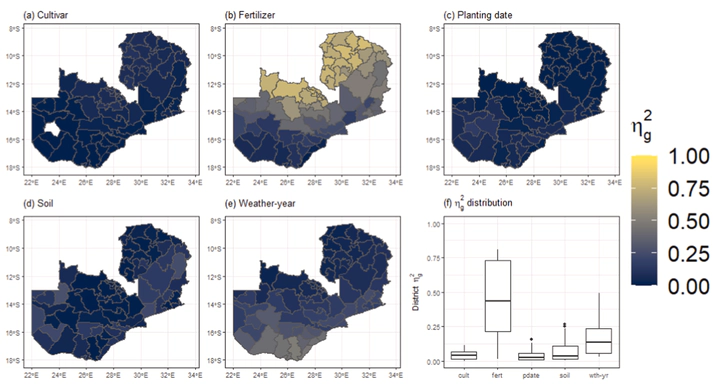
Abstract
Smallholder agriculture is critical for current and future food security, yet quantifying the sources of smallholder yield variance remains a major challenge. Attributing yield variance to farmer management, as opposed to soil and weather constraints, is an important step to understanding the impact of farmer decision-making, in a context where smallholder farmers use a wide range of management practices and may have limited access to fertilizer. This study used a process-based crop model to simulate smallholder maize (Zea mays) yield at the district-level in Zambia and quantify the percent of yield variance (effect size) attributed to soil, weather, and three management inputs (cultivar, fertilizer, planting date). Effect sizes were calculated via an ANOVA variance decomposition. Further, to better understand the treatment effects of management practices, effect sizes were calculated both for all years combined and for individual years. We found that farmer management decisions explained 27–82 % of total yield variance for different agro-ecological regions in Zambia, primarily due to fertilizer impact. Fertilizer explained 45 % of yield variance for the average district, although its effect was much larger in northern districts of Zambia that typically have higher precipitation, where it explained 72 % of yield variance on average. When fixing a specific fertilizer amount, the “low-cost” management options of varying planting dates and cultivars explained 20–28 % of yield variance, with some regional variation. To better understand why management practices impact yield more in particular years, we performed a correlation analysis comparing yearly management effect sizes with four meteorologically based variables: total growing season precipitation, rainy season onset, extreme heat degree days, and longest dry spell. Results showed that fertilizer’s impact generally increased under favorable weather conditions, and planting date’s impact increased under adverse weather conditions. This study demonstrates how a national yield variance decomposition can be used to understand where specific management interventions would have a greater impact and can provide policymakers with quantification of soil, weather, and management effects. In addition, the variance composition can easily be adapted to a different range of management inputs, such as other cultivars or fertilizer quantities, and can also be used to assess the effect size of management adaptations under climate change.